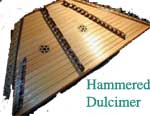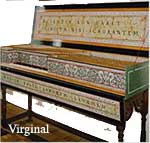ANCESTORY of the PIANO
The first historical mention of instruments is in Genesis 4:21,
where Jubal is called the father of all those who handle the harp
and organ. The first instrument in history to have a "keyboard
was the "Hydraulis', the precursor of the modern organ, built
in Greece about 220 B.C. The Hydraulis was devised by Ctebius,
an Alexandrian engineer, and practical theoretician as a demonstration
of the principle of hydraulics. By the Second Century A.D. the
organ was commonly used at important festivities in Greece and
the Roman Empire.
 The earliest keyboards
were played with the hands, wrists, fists, knees, or feet. Spacing
of the tabs, levers, pulls, etc., was according to the distance
between the pipes they activated. This space could be 10 centimeters
or more. Up to the 13th Century the scales were diatonic (as in
GABCDEF) rather than the twelve tone chromatic scale we use today.
A common arrangement was to use 'C' as the first key and include
an extra note Bb", In a two-octave keyboard. Mechanisms added
to 'abridge the gap" made it possible to space the keys evenly.
The earliest keyboards
were played with the hands, wrists, fists, knees, or feet. Spacing
of the tabs, levers, pulls, etc., was according to the distance
between the pipes they activated. This space could be 10 centimeters
or more. Up to the 13th Century the scales were diatonic (as in
GABCDEF) rather than the twelve tone chromatic scale we use today.
A common arrangement was to use 'C' as the first key and include
an extra note Bb", In a two-octave keyboard. Mechanisms added
to 'abridge the gap" made it possible to space the keys evenly.
 Throughout the 14th
Century, the increasing practices of chromatism and transposition
demanded the progressive addition of keys. Keyboard variations
Included changes in the distance between the octaves, the size
and shape of the keys (natural heads were stubby and short until
the end of the 17th Century), depth of touch, color (such as dark
naturals and light sharps), curved keyboards, rows of keys in
different formats, more than twelve keys in a chromatic scale,
etc. Keyboards reached five octaves by about 1700, six octaves
by around 1800 and seven octaves by about 1900.
Throughout the 14th
Century, the increasing practices of chromatism and transposition
demanded the progressive addition of keys. Keyboard variations
Included changes in the distance between the octaves, the size
and shape of the keys (natural heads were stubby and short until
the end of the 17th Century), depth of touch, color (such as dark
naturals and light sharps), curved keyboards, rows of keys in
different formats, more than twelve keys in a chromatic scale,
etc. Keyboards reached five octaves by about 1700, six octaves
by around 1800 and seven octaves by about 1900.
Modern pianos generally are of seven octaves and a third, while
modern organ manuals usually have a maximum of five octaves. Some
pianos have had up to eight octaves.
 The idea of multiple strings on one instrument to play a scale with a hammer is not new. The dulcimer and it's relatives were played with hand held hammers. The earliest dulcimer of record is pictured In a 12th Century book cover (Kettlewell, 1980). W. J. Clark (1975) , however , credits the invention of the dulcimer (which he calls the first piano) to a Persian named Abu Nasre Farabi of the 9th Century A.D. who played a multi-stringed dulcimer called the Santur with two hand held mallets. The validity of this claim is disputed by Kettlewell.
The idea of multiple strings on one instrument to play a scale with a hammer is not new. The dulcimer and it's relatives were played with hand held hammers. The earliest dulcimer of record is pictured In a 12th Century book cover (Kettlewell, 1980). W. J. Clark (1975) , however , credits the invention of the dulcimer (which he calls the first piano) to a Persian named Abu Nasre Farabi of the 9th Century A.D. who played a multi-stringed dulcimer called the Santur with two hand held mallets. The validity of this claim is disputed by Kettlewell.
 The 14th and 15th
Centuries saw the development of various kinds of keyboard stringed
instruments. Those with hammers Included the chekker, dulce melos,
and clavichord. Among the plucked instruments were the virginal,
spinet and harpsichord.
The 14th and 15th
Centuries saw the development of various kinds of keyboard stringed
instruments. Those with hammers Included the chekker, dulce melos,
and clavichord. Among the plucked instruments were the virginal,
spinet and harpsichord.
Organ
History
Webring
for keyboard instrument sites
Go to beginning
of Piano History

 The earliest keyboards
were played with the hands, wrists, fists, knees, or feet. Spacing
of the tabs, levers, pulls, etc., was according to the distance
between the pipes they activated. This space could be 10 centimeters
or more. Up to the 13th Century the scales were diatonic (as in
GABCDEF) rather than the twelve tone chromatic scale we use today.
A common arrangement was to use 'C' as the first key and include
an extra note Bb", In a two-octave keyboard. Mechanisms added
to 'abridge the gap" made it possible to space the keys evenly.
The earliest keyboards
were played with the hands, wrists, fists, knees, or feet. Spacing
of the tabs, levers, pulls, etc., was according to the distance
between the pipes they activated. This space could be 10 centimeters
or more. Up to the 13th Century the scales were diatonic (as in
GABCDEF) rather than the twelve tone chromatic scale we use today.
A common arrangement was to use 'C' as the first key and include
an extra note Bb", In a two-octave keyboard. Mechanisms added
to 'abridge the gap" made it possible to space the keys evenly. Throughout the 14th
Century, the increasing practices of chromatism and transposition
demanded the progressive addition of keys. Keyboard variations
Included changes in the distance between the octaves, the size
and shape of the keys (natural heads were stubby and short until
the end of the 17th Century), depth of touch, color (such as dark
naturals and light sharps), curved keyboards, rows of keys in
different formats, more than twelve keys in a chromatic scale,
etc. Keyboards reached five octaves by about 1700, six octaves
by around 1800 and seven octaves by about 1900.
Throughout the 14th
Century, the increasing practices of chromatism and transposition
demanded the progressive addition of keys. Keyboard variations
Included changes in the distance between the octaves, the size
and shape of the keys (natural heads were stubby and short until
the end of the 17th Century), depth of touch, color (such as dark
naturals and light sharps), curved keyboards, rows of keys in
different formats, more than twelve keys in a chromatic scale,
etc. Keyboards reached five octaves by about 1700, six octaves
by around 1800 and seven octaves by about 1900. The idea of multiple strings on one instrument to play a scale with a hammer is not new. The dulcimer and it's relatives were played with hand held hammers. The earliest dulcimer of record is pictured In a 12th Century book cover (Kettlewell, 1980). W. J. Clark (1975) , however , credits the invention of the dulcimer (which he calls the first piano) to a Persian named Abu Nasre Farabi of the 9th Century A.D. who played a multi-stringed dulcimer called the Santur with two hand held mallets. The validity of this claim is disputed by Kettlewell.
The idea of multiple strings on one instrument to play a scale with a hammer is not new. The dulcimer and it's relatives were played with hand held hammers. The earliest dulcimer of record is pictured In a 12th Century book cover (Kettlewell, 1980). W. J. Clark (1975) , however , credits the invention of the dulcimer (which he calls the first piano) to a Persian named Abu Nasre Farabi of the 9th Century A.D. who played a multi-stringed dulcimer called the Santur with two hand held mallets. The validity of this claim is disputed by Kettlewell. The 14th and 15th
Centuries saw the development of various kinds of keyboard stringed
instruments. Those with hammers Included the chekker, dulce melos,
and clavichord. Among the plucked instruments were the virginal,
spinet and harpsichord.
The 14th and 15th
Centuries saw the development of various kinds of keyboard stringed
instruments. Those with hammers Included the chekker, dulce melos,
and clavichord. Among the plucked instruments were the virginal,
spinet and harpsichord.